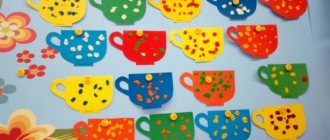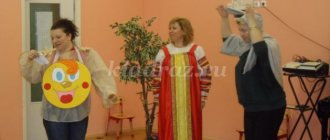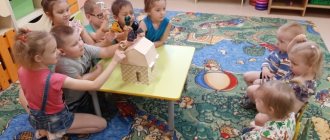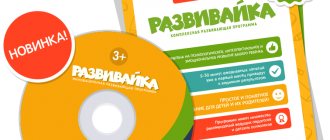Progress of the game.
Children are asked to come up with and show several options for behavior for a specific task: a person “goes”
,
“sits”
,
“runs”
,
“raises his hand”
,
“listens”
, etc.
Each child comes up with his own behavior, and the other children must guess what he is doing and where he is. The same action looks different under different conditions.
Children are divided into 2-3 creative groups , and each receives a specific task.
I “sit” task
.Possible options:
a) sit in front of the TV;
b) sit in the circus;
c) sit in the dentist’s office;
d) sit at the chessboard;
e) sit with a fishing rod on the river bank, etc.
II “go” task
.Possible options:
a) walk along the road, surrounded by puddles and mud;
b) walk on hot sand;
c) walk along the deck of the ship;
d) walk along a log or a narrow bridge;
e) walk along a narrow mountain path, etc.
III “run” task
.Possible options:
a) run away, being late for the theater ;
b) run away from an angry dog;
c) run when caught in the rain;
d) run, playing blind man's buff, etc.
IV - task “waving your arms”
.Possible options:
a) drive away mosquitoes;
b) give a signal to the ship to be noticed;
c) dry wet hands, etc.
V - task “Catch the little animal”
.Possible options:
a) cat;
b) parrot;
c) grasshopper, etc.
Card No. 10 “TRANSFORMATION OF AN OBJECT”
Target. Develop a sense of faith and truth, courage, intelligence, imagination and fantasy.
At the age of 2–3 years, the child actively manipulates objects and, with the help of an adult, finds ways to use them. Actions with the toy are still monotonous and repeatable: feeds the doll, puts it to bed, takes it for a walk. But then the baby gets his first experience of artistic communication with a character, when the same doll appears before the child in a slightly different guise and plays a theatrical role; he is caught up in the action. Getting to know the theater as a special world of artistic images takes place in an atmosphere of magic, festivity, and high spirits. From the very first meeting, it is important to evoke an emotionally positive response in the child’s soul and encourage him to actively perceive. At first, these will be short dramatizations, for example, a portrait sketch and a dialogue between the teacher and the character with the children.
…
Educator. The Katya doll has come to you in an elegant dress. What does Katya have? (Bow.) Yes, it's a bow. And what's that? (Hat.) What's on her legs? (Boots.) Let's ask Katya to dance: “Katya, dance.” (Katya dances.) Katya, our children also know how to dance. Look. (Children dance to a familiar tune.)
Kate. I am Katya doll. I have a beautiful dress and hat.
I like singing. I'll sing you a funny song. (Children listen to the song.) Educator. Good song? Come to us, Katya, again.
In the first dialogue with the doll-actress, the child is attracted by the unusual behavior of the doll, the very possibility of communicating with her.
Further meetings with a toy or a favorite doll as a close, long-familiar character will help expand contact with children and involve them in playful communication. The sequence of steps taken by adults has a beneficial effect on children’s ability to transform. The child’s need for self-expression manifests itself in involuntary movement, singing along, and playing along with simple musical instruments. For him, both the fact of participating in the game and watching the performance and participation of other children are important. And if the baby is not yet internally ready to join the general game, then in the future participation in it will be more and more attractive, provided that it is non-violent, natural entry into the game situation. For example, the Katya doll names and shows musical instruments that children have already become acquainted with in music classes, invites everyone to go together on a sleigh with bells, and distributes instruments (rattles, bells, small tambourines). Children involved in play and from slide to slide.
In classes, part of which is theatrical play, an atmosphere of improvisation should reign. The teacher, observing the children while working, identifies the most active, adequately functioning children and attracts the attention of others to them. Thus, when dramatizing the nursery rhyme “The cat went into the woods,” the adult uses the slightest manifestations of the children’s desire to participate in the game. The teacher shows the toy to the children and says:
…
The cat went into the woods (Children imitate the cat’s gait.)
The cat found a belt, (Children put their hands on the belt.)
Dressed up, (Children admire the belt.)
Turned back (Children turn and go in the other direction.)
He began to rock the cradle: (Children fold their hands into a “cradle.”)
Bye-bye, bye-bye, (Children sing along.)
Lie down, Galinka, quickly,
Get up, Galinka, with the little dawn! (The teacher approaches the child with a toy, bows to him and calls his name.)
The game is repeated 3-4 times.
By improvising, children gradually gain experience in artistic perception: they listen to the word, observe the expressive movement of the character, intonation. Wind noise conveyed in a light glissando on a metallophone; silvery bell ringing performed on a triangle; the clatter of steps imitated by wooden blocks - all the sounds accompanying the teacher’s expressive story help to complete the artistic image proposed by adults in the child’s imagination, cultivating a special, aesthetic attitude towards the world. Using children's tendency to imitate, it is possible to achieve expressive imitation of various sounds of animate and inanimate nature by voice. In this case, you should go from the simplest exercises to more complex ones. For example, children, pretending to be the wind, puff out their cheeks, doing it diligently and carefree. But when they are faced with the task of blowing in such a way as to scare away the evil wolf, then, instantly transforming, the children’s faces become frightening, and a wide variety of feelings are conveyed in their rounded eyes.
Performing actions according to a model, repeated repetitions of movements contribute to the formation of muscle sensations, special skills and abilities (show your arms, stick out your leg, stamp, wave a handkerchief, spin, jump). The teacher records the successes of each child, notes new achievements; the playful atmosphere awakens children's emotions.
Familiar poems and songs are good game material. Dramatization of works of small folklore forms is a kind of training for emotional manifestations. These works conceal in every line a special mood, a plot, requiring the teacher to master the technique of role-playing with the help of movements, intonation, and facial expressions.
Experts advise starting children’s acquaintance with the theater with puppet theater, which has a strong emotional impact on children. By showing mini-plays in a tabletop theater, on a flannelgraph, using the bibabo technique, with the help of individual toys and dolls, the teacher conveys a palette of experiences through intonation, and, if possible, through the external actions of the hero. Children of this age can perceive contrasting moods (“fun – sad”). Children react most emotionally to large, bright toys that cause them genuine delight. This toy is characterized by low mobility, but it is always the center of attention of children. Everyone wants to get closer to her, touch her, stroke her, that is, express their attitude towards her. With the help of such toys, you can organize small concerts for children, act out sketches-dialogues, show dramatizations-sketches, dramatizations-portraits. On a flannelgraph you can build an entire scene with several characters, whose mood is emphasized only by the intonation of the voice of the teacher acting for them. At the request of the teacher, children name the characters and their actions, but initially imitate their voices and behavior only when shown by an adult. The design of bibabo dolls allows you to depict a character in different poses, through expressive movement and intonation. The use of puppet theater should be limited to the introduction of one or two characters, who must move at such a speed that children can follow them.
What is common in the recommendations for conducting a theatrical performance is that all words and movements of the characters should be clearly defined, differ in character and mood, and follow at a slow pace. The action should be short-lived. When preparing mini-performances, the teacher should prepare the place for the show in advance, equipping it with various equipment, materials and paraphernalia. The teacher must learn all texts by heart in order to more actively get used to the role, have time to monitor the children’s reactions and interact with them.
By observing children, a sensitive teacher learns about the level of development of their emotional world, gaming skills. In order to liberate and eliminate the internal constraint of children, special sketches and exercises for the development of emotions can be carried out. For this purpose, various mood states are proposed, emphasizing the feelings of the children themselves or the characters presented. The expressive capabilities of voice, music, movement (graphic representation) should be used, focusing the attention of children on this, inviting them to name the mood and express it in voice and movement. These are the simplest sketches “The sun rises” and “The sun sets”, in which the emotional state is conveyed to children with the help of verbal (the sun rises and sets) and musical
(the melody moves up and down) settings that encourage you to perform the appropriate movements. When performing etudes, you should rely on program nursery rhymes, songs and chants that are similar in theme, for example, “Sun, Bucket.” Gradually, the emotional and thematic field of dramatization expands, the musical image enhances the effect of the generalized dramatic image.
The experience gained should be used when reading fairy tales, depicting the characters in their faces. When reading fairy tales, the teacher, with the help of facial expressions, gestures, posture, and intonation, must convey to the children the meaning of the work and reveal the characters of its heroes.
Gradually, children are introduced to the dramatic theater, in which all roles are performed by one adult actor. When reading and acting out folklore works, it is very good to include folk music as an introduction, conclusion, and background to enhance the emotional perception of the fairy tale by children.
The baby does not immediately become aware of himself in the role. At first, he doesn’t understand who they are talking about: “Here a little bear came out into the clearing. Little bear, bow, spin, come closer, give me your paw.” And only when the teacher takes the baby by the hand and puts a bear hat on him, the child understands that he is the bear, this is what they are saying about him, and he smiles in response. Accompanied by general applause, the baby will imitate the habits of the bear, focusing on the teacher and waiting for his approval. The teacher must communicate as closely as possible with each child. Only by addressing each individual individually do the necessary qualities – memory, thinking, imagination, attention – develop most effectively.
From the first days of the school year, it is important to focus children on the need to create a subject-spatial environment. When acting out small plays, performing performances in a tabletop theater, you need to pay attention to the attributes, decorations, and various equipment. So, when dramatizing V. Suteev’s fairy tale “Who said “meow”?”, after the children have seen the puppet show, when returning to the play, you can give them the opportunity to carefully examine the scenery and answer the questions: “Where did the puppy live? What kind of house did he have? How did the puppy become clean again?” Then you can offer to create an applique based on the fairy tale (the teacher does it, turning to the child: “Let’s do it together”), depict some of the characters, their houses, and a pond. You can, having interested the children in the plot, play out individual episodes with them and, encouraging them to arrange the scene of action, designate the puppy’s house, his favorite rug, household items, and the street in the group room.
Often it is difficult for a child to enter into a role due to the fact that he cannot imagine the situation in which the action takes place, the appearance of this or that character, does not understand his behavior, does not know his habits. To develop children's imagination and acquire the necessary knowledge, one should talk about the habits of domestic animals, their friends and enemies, the need to protect them and take care of them. You can use illustrative material (reproductions, drawings, videos) to clearly show children what an unfamiliar animal looks like, or to give them the opportunity to admire familiar animals presented by the artist from an unusual angle that emphasizes their beauty, dexterity or strength.
Specially organized performances by older children and adults bring great joy to children of this age. These can be either puppet or dramatic performances that bring the kids a festive mood. The material for such performances can be very diverse. Children of the first junior group can perceive small puppet scenes in which two or three characters participate, appearing mostly one by one. Older children show plays that are feasible for performance: “The Fox and the Hare”, “The Little Goats and the Wolf”, “The Three Bears”, etc., which are accessible to the perception of children. At the same time, older children should know dramatic material well and pronounce phrases clearly.
In order to evoke the greatest emotional uplift in the audience, it is necessary to create a festive atmosphere and prepare a place for the performance. The performance can take place both in the hall and in a group room at the most convenient time. To decorate the room, children from older groups should be involved, especially those participating in the upcoming performance. The children can be instructed to set up a screen, prepare dolls, costumes, props, arrange everything necessary for the performance, hang balloons, decorate the walls with appliqué, pictures, decorate the screen (with rain, trees drawn and cut out of whatman paper, houses, animal figures, etc.) .
Children of the first junior group must participate in the general holidays of the kindergarten. In such events, as a rule, some of the material is specifically designed for the perception of children of this age. For example, in folk holidays these can be small puppet scenes with Parsley on a screen, staging nursery rhymes, the participation of large dolls, etc. Kids can participate in the improvisation of movements to music in combination with the word, in the dramatization of works of small forms.
Theatrical play allows the child to enter into a special relationship with the world around him, which he cannot enter into on his own due to his limited capabilities. The preschooler gets the opportunity to actively communicate with adults in artistic and play activities, which, in turn, contributes to the development of positive emotions, imagination, and subsequently correlate various impressions with his personal experience in independent play activities.
Progress of the game.
The object is placed on a chair in the center of the circle or passed around the circle from one child to another. Everyone must act with the object in their own way, justifying its new purpose, so that the essence of the transformation is clear. Options for the transformation of different objects:
a) pencil or stick - key, screwdriver, fork, spoon, syringe, thermometer, toothbrush, paint brush, pipe, comb, etc.;
b) a small ball - an apple, a shell, a snowball, a potato , a stone, a hedgehog, a bun, a chicken, etc.;
c) notebook - mirror, flashlight, soap, chocolate, shoe brush, game.
You can transform a chair or a wooden cube, then children must justify the conventional name of the object.
For example, a large wooden cube can be turned into a royal throne, flowerbed, monument, bonfire, etc.
Card No. 11 “KING (version of the folk game)
»
Target. Develop actions with imaginary objects, the ability to act in concert.



